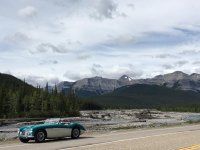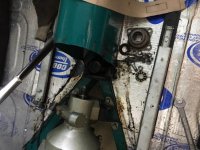rvm
Freshman Member
Offline
The nut fell off!
Yesterday I was out in the foothills of the rockies having a great day when the flange coupling seperated from the overdrive after hitting a cattle guard at too high a speed. The castellated nut had backed itself off. Then cotter pin obviously not in place. Duh!! The flange took a beating on the teeth but I have sourced a replacement already. The 1st 4 rows of threads on the annulus shaft were damaged. So what size die to repair the threads on the annulus shaft would I need. TPI appears to measures 16 and the castellated nut measures approx 11/16th " but don't know if its BSF BSW or something else.
Thanks
Ross
Yesterday I was out in the foothills of the rockies having a great day when the flange coupling seperated from the overdrive after hitting a cattle guard at too high a speed. The castellated nut had backed itself off. Then cotter pin obviously not in place. Duh!! The flange took a beating on the teeth but I have sourced a replacement already. The 1st 4 rows of threads on the annulus shaft were damaged. So what size die to repair the threads on the annulus shaft would I need. TPI appears to measures 16 and the castellated nut measures approx 11/16th " but don't know if its BSF BSW or something else.
Thanks
Ross
Attachments
Last edited:

 Hi Guest!
Hi Guest!

 smilie in place of the real @
smilie in place of the real @
 Pretty Please - add it to our Events forum(s) and add to the calendar! >>
Pretty Please - add it to our Events forum(s) and add to the calendar! >> 




